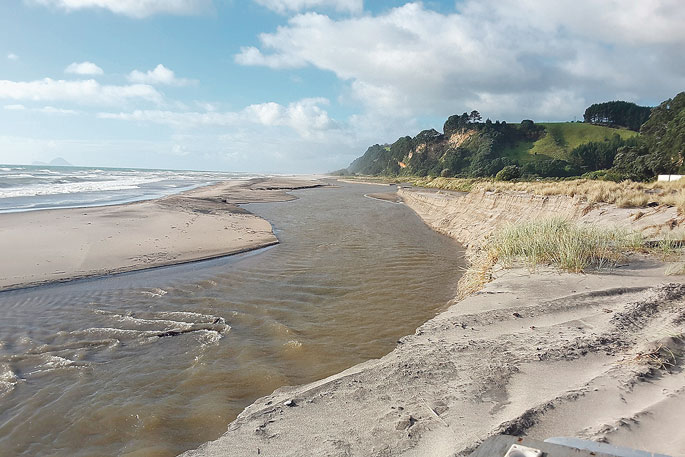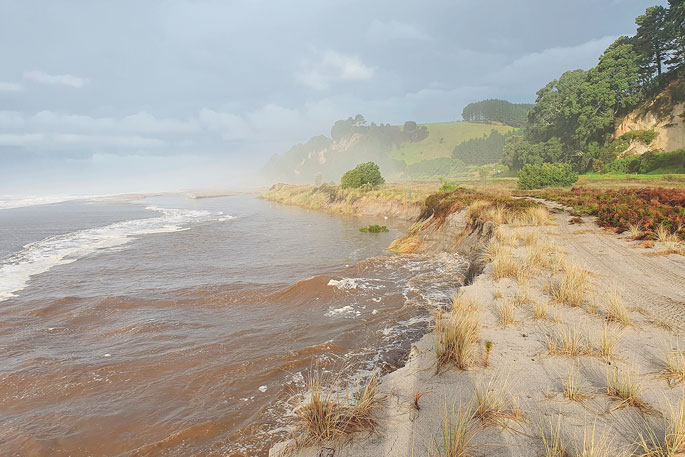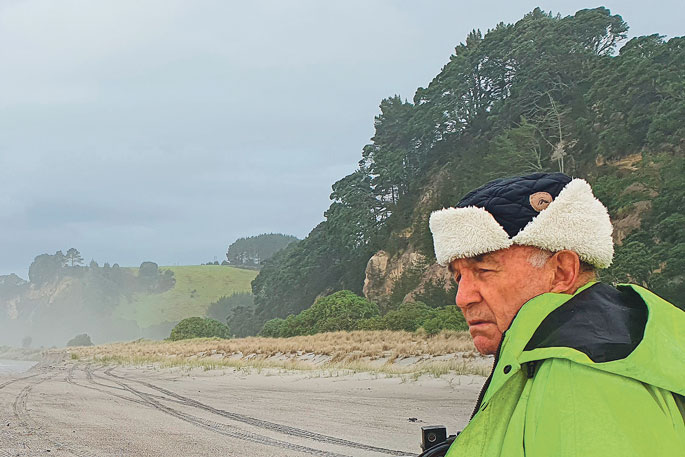Pikowai resident Rodger Allan is worried there soon will not be any sand dunes left in front of his home if the Bay of Plenty Regional Council does not take action, as it has in the past.
The Mimiha and Herepuru streams that normally flow out of the valley along the Pikowai straight and empty into the ocean have recently been redirected along the beach by a naturally formed sandbank just offshore.
Rodger, who is 80 years old and has operated as an orchard developer around the Bay of Plenty for over 50 years, says the water is washing away the sand dunes between the beach and the railway line.
It's something that occurs from time to time, but is easily corrected.
The last time this happened, around two years ago, he says the river had eaten away 10 metres of dune area in just four days.
When he told the regional council, they came out with a digger and dug a trench through the sandbank to redirect the river water away from the dunes.
He says that this time the erosion is worse than before.
'[The stream entrance] blocks up when you get a storm and it needs opening up, otherwise it starts heading along the beach.
'We've done it ourselves once or twice since the regional council did it two years back. If you get it quick enough, you can just do it with a shovel. Once the water starts running through, it just gouges out its own channel and goes back to its natural place. This time it's got away on us and now [the sandbank] is too big. It would take an army half a day, but with a digger it's 10 minutes work.”
However, this time, the regional council has refused to take any action, saying it is just nature taking its course.
 The Mimiha and Herepuru streams are cutting a path along the beach, eating into sand dunes as they go. The above photo was taken two weeks ago, and below photo was taken last week after the storm.
The Mimiha and Herepuru streams are cutting a path along the beach, eating into sand dunes as they go. The above photo was taken two weeks ago, and below photo was taken last week after the storm.

Regional council land management officer Rusty Knutson says dunes are dynamic and change all the time.
'The new stream direction is a naturally occurring event. While the stream often goes directly out to sea, this course is sometimes blocked - usually by sand after strong winds or storm events - forcing it to go in a different direction, as it has many times in the past. In this case, the new pathway is parallel to the beach, but it's unlikely that this course will be permanent.
'When erosion does occur, lost sand typically accumulates in a sand bank offshore. It then makes its way back onshore when the wave and wind conditions are more favourable to dune formation.”
Rodger says in the past, farmers have brought their tractors down and opened the sand bank that was blocking the stream from heading out to sea.
"You go to jail if you do that nowadays. You need a resource consent and permission from the iwi and this and that and the other thing. [The regional council] spend all this money to restore the sandhills, spray them for weeds and plant pīngao and yet they let them get washed away.”
He says he and his neighbours look after the dotterels on the beach in front of his home, fencing off areas where they are nesting.
'There were about seven nests on this beach last year. Now the river's right on top of where they normally nest.”
He says he has voiced concern to the council that the railway tracks could be in danger, but Knutson says there are no indications to suggest they are in danger, currently, or that dotterels willd be adversely affected.
'While the dotterels will be nesting soon, they will adapt to the current direction and placement of the stream to find a suitable place to nest. Dotterels are more likely to be affected by the presence of people, vehicles and dogs on the beach,” says Knutson.
-Local Democracy Reporting is Public Interest Journalism funded through NZ On Air




0 comments
Leave a Comment
You must be logged in to make a comment.